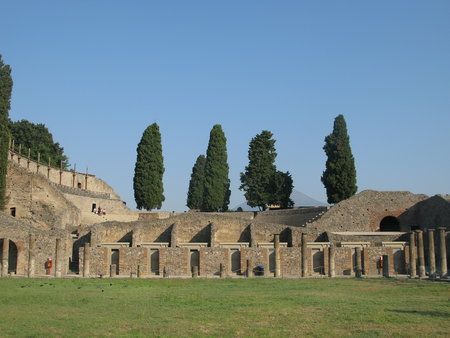Cruise Ports: Italy's Pompeii and Herculaneum
Pompeii was frozen in time when a volcano erupted nearly 2,000 years ago. Today, the city and its smaller neighbor, Herculaneum, are must-see attractions for tourists.

The ruins at Pompeii. Photo by C. Stapen.
From Naples, a major cruise port, you can travel back in time more than 2,000 years to Aug. 24, 79 AD, when the volcano Mt. Vesuvius, erupted, burying Pompeii under ash and Herculaneum under boiling mud. Situated in the fertile valleys of what’s now Italy’s Campania region, Pompeii and Herculaneum together rank as a UNESCO World Heritage site.
Consider traveling in fall or spring when crowds thin and prices are lower than in summer’s peak season.
In both Pompeii and Herculaneum, falling buildings crushed people, but most died from the noxious gases released by the volcano. The casts of people and animals caught in their last agonizing moments of life are some of Pompeii’s and Herculaneum’s most powerful icons.
Over time flesh decomposed, leaving just a mud or ash covered skeleton. Excavators preserved the shape of the dead by injecting plaster to fill the empty spaces, creating a carapace or mold. The sculptural softness of the objects belies the captured terror. Among the casts: a man curled hopelessly in a fetal position; a pregnant woman, forever big with child; and a dog on his back, feet in the air as if wriggling to get free of a tether. The carapaces on display rotate. More of them may be seen in Naples’ archeological museum and other facilities.
Although the stone streets and buildings in both Pompeii and Herculaneum evoke life eons ago, the visitor experience is distinct. Both sites are worth seeing.
Here’s how cruisers and day trippers can choose which lost world to enter.
>>Related:
Cruise Ports: Stockholm for Families
Cruise Ports: Dogsledding in Juneau
Cruise Ports: Close Encounters with Glaciers, Seward, AK
Pompeii
Celebrated Pompeii, located 15 miles southeast of Naples, attracts 3 million people annually, making it one of Italy’s top archeological sites. With about 120 of its 165 acres excavated, Pompeii is big. It thrived as a prosperous metropolis with a population estimated at nearly 20,000.
We paced streets where centuries of chariot wheels cut tracks in the stone. We saw public baths, shops, temple pillars, and places of prostitution whose doorway frescoes detailed each working woman’s specialty. The roofed House of Menander showcased a prominent citizen’s home, one wealthy enough to have frescoes, floor mosaics and wall niches for decorations in main rooms. Additional highlights include the Tempio di Apollo (Temple of Apollo), the Anfiteatro (Amphitheater), the well-preserved Stabian Thermae (baths), the Casa dei Vettii (House of the Vettii) adorned with frescoes, some of which are erotic, as well as the frescoes in the Villa dei Misteri (House of the Mysteries).
To mitigate elbowing through throngs and lining up to peer into once occupied bedrooms, we arrived when Pompeii first opened and we avoided the main gate, Porta Marina. Instead, we entered through the less busy Porta Stabia and worked our way back to exit through Porta Marina.
Herculaneum
Smaller and lesser-known than Pompeii, Herculaneum draws about 300,000 visitors annually. The total size of the town is between 40 to 55 acres, with only about one-third excavated. Because modern-day Ercolano sits on top of sections of Herculaneum, only about half the ancient site has been revealed. Given the site’s small size compared to Herculaneum, you may see crowds but you likely won’t be walking with throngs of other tourists all day.
Situated six miles south of Naples, Herculaneum was once home to 4,000-5,000 people. Herculaneum was located west of the volcano. When Vesuvius erupted, Herculaneum experienced less ash, and much boiling mud that rose up from the ground. Seeping into crevices and encasing objects, the mud better preserved details than the fiery ash that rained down on Pompeii.
The mud spared roofs and carbonized wood so some buildings contain shelves and beams. More mosaics remain than in Pompeii. Don’t miss the vivid, tiled designs in the Terme Femminili (Women’s Baths) and the Casa del Nettuno ed Anfitrite ( House of Neptune and Amphitrite).
As a result Herculaneum afforded us a visceral sense of a common day minutes before a deadly catastrophe struck. The streets with their taverns, baths, and temples seemed like stage sets, ready for townspeople to enter on cue.
ACTIVA BioACTIVE Bulk Flow Marks Pulpdent’s First Major Product Release in 4 Years
December 12th 2024Next-generation bulk-fill dental restorative raises the standard of care for bulk-fill procedures by providing natural remineralization support, while also overcoming current bulk-fill limitations.